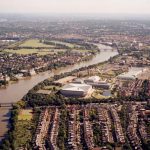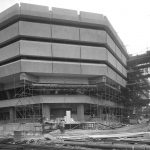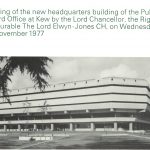Date/Time
Date(s) - Monday 16 January 2017
8:00 pm - 9:00 pm
Location
Duke Street Church
Categories No Categories
Paul Davies, who lives in Kew and is Operations Director for The National Archives, talked about the history of The National Archives’ site. Previously known as Kew Meadows, it played an important role in both world wars and housed the Ministry of Labour and an experimental open-plan office building before the arrival of the Public Record Office almost 40 years ago. He talked about the 1990s extension of what has now become The National Archives and the internal remodelling of some of the public access areas, and brought us up to date with what has been happening with the neighbouring former Inland Revenue site.
Following a career as a military engineer in the British Army, Paul Davies worked in estates and operational leadership roles at the British Library and the Imperial War Museum. He is now responsible for estates and facilities, security, IT operations, corporate and strategic planning, and human resources at The National Archives.
John Foley’s report on the talk
Stand on Kew Gardens station platform any day, especially in summer, and observe the crowds arriving, visitors to the world-famous gardens. But as Paul Davies explained in his excellent talk, Kew has a more recent rival attraction which these days also brings many to Kew: The National Archives, whose home has been on a riverside site to the east of the railway for the past 40 years.
Paul began his story back in Victorian days, showing aerial photographs of Kew as it was in the 1890s, the tree-lined streets of still familiar suburban mansions clearly recognisable. But at that time the area bordering the southern bank of the Thames was largely waste ground, or covered by cabbage patches and the remains of market gardens. Land registry records show previous owners as Miss Ratcliffe and Mr Popham (the latter petitioning the then Railway Company to build a footpath along the railway embankment to the riverbank, today’s Occupation Way).
Building on the land began in the First World War, with construction of Government offices and a wartime military hospital. Long military rows of barrack-like single storey buildings appeared (the last of which vanished only in the 1990s when vacated by the Inland Revenue, the final occupants). Later, in the Second World War, the site formed an important part of the war effort, in production of military maps, with American participation, as well as later housing Italian prisoners of war. The map research department somehow attracted the attention of a 1944 doodlebug, with resulting death and destruction (the nearby Chrysler Motors site also “copping” a V2 rocket: more devastation).
In the late 1960s the Central London premises of the Public Record Office (as it was then called) was bursting at its seams. A brand new site was sought. Bletchley Garden City (Milton Keynes) was considered, but Kew, nearer to central London, was chosen. When Kew residents saw the plans they protested, with resulting delay. Eventually the developers agreed to reduce the height of the proposed new building by 55 feet. And in 1977, the then state-of-the-art giant concrete building, pillbox-like in design – rather brutalistic to some – was first opened.
Not the end of the story of course, as construction in the 1990s of the (more soothing in appearance?) neighbouring extension to the east enabled the closure of the remaining PRO facilities in Chancery Lane. Paul described the careful thought which had to be given to the design and construction of these now nationally important buildings, especially on a site so near the river. The charming ornamental pools, so pleasing to the eye, form part of a flood defence scheme, while the buildings are supported by raised plinths designed so that no material can be stored in an area vulnerable to flooding: a real possibility and horrible historic reality. Paul showed photographs of the former governments buildings and nearby streets submerged by the terrible floods of 1928.
And so The National Archives are settled in their Thames-side home at Kew, nowsurrounded on all sides by expensive residential development, as well as by Kew Retail Park, a total transformation of the area from what it was less than half a century ago. Paul explained the possible developments anticipated with regard to modern storage of data and records (robots have already arrived!) as the world moves into the digital age. But in the meantime what would “Poor Fred”, Caroline of Ansbach and King George III have made of it all?!


